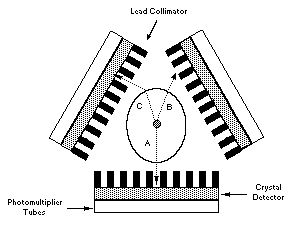
| FIG. 2 |
 |
| SPECT scanners utilize the principle of collimation to determine the trajectory of g rays produced by single-photon emitting nuclides. A collimator is a lead block containing many tiny holes that is interposed between the subject and the radiation detector. The holes are sufficiently long and narrow so as to permit only photons of essentially parallel trajectory to pass through the collimator and reach the detector (A). Given knowledge of the orientation of a collimator's holes, the original path of a detected photon is linearly extrapolated. In contrast to parallel photons, g rays that deviate slightly are absorbed by the lead and go undetected (B). Compton scattering (C) causes g rays to deviate from their original trajectory and may result in the false interpretation of a photon's path and origin. In contrast to PET scanners, SPECT radiation detectors typically rotate around the subject's head in synchrony, thus acquiring multiple views or projections from many imaging angles over an entire 360°. |
| Back to Chapter |
published 2000